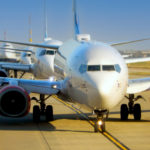The race to develop electric vertical take-off and landing (eVTOL) aircraft is heating up – Alan Peaford assesses who the winners and losers might be.
There is a famous phrase when talking about revolution: First they ignore you; then they laugh; then they listen; then they fight, then we win.
It has been attributed to Mahatma Gandhi and to trade unionist Nicholas Klein.
But whoever first coined it understood the process of change very well.
The new age of aviation inventors and revolutionaries would do well to look at this and perhaps to the fable of the tortoise and the hare. Both go a long way to explaining what is happening in our drive for developing future aircraft, whether they be hybrid or fully electric regional aircraft or eVTOL air taxis for urban air mobility.
Capturing the imagination
Like anyone who watched the Jetsons, the idea of urban air mobility – taking to the skies above the snarling traffic in the streets below – is one that captures the imagination.
That excitement was paramount back in 2019 when the first Global Urban Air Summit took place at Farnborough. It was reported that there were already more than 250 platforms in development, vying for the seed corn grant funding or investment to take ideas from the sketch pad to the drawing board and beyond.
They had been concepts at aerospace trade shows for many years, mostly ignored by the airframers and the main players in the industry, or scorned because of the cost and the frustration around certification and airworthiness approval from regulators.
By the time of that inaugural GUAS, regulators had started to take notice and the OEMS led by Airbus and Boeing had made their own attempts at what a future aircraft could look like. They were clearly listening.
Sustainability
With the underlying environmental issues that were challenging the aerospace industry globally, the whole idea of being part of the alternatively powered air transport vehicle revolution was an appealing one.
Of course many of the investors hungered for quick wins – or good publicity – and even governments pushed cash into grant programmes that in the main fell to primes to filter down to the universities or small engineering firms or entrepreneurs who had the vision to innovate.
Economies were strong then. But Covid struck, investment money dried up while pressure on emissions increased. Many of the platforms that sounded so exciting in 2019 had stalled or disappeared by 2021 – including Airbus person eVTOL project, Vahana, after more than 100 test flights.
Progress made
Some eye-openers gave a boost to those of us who dreamed.
A flying car prototype, Air Car, which has been in development for more than 20 years, made its maiden manned test-flight between two Slovakian cities and in 2021 was awarded an airworthiness certificate by the Slovak Transport Authority. It has now clocked more than 70 hours of test flights involving 200 take offs and landings following EASA standards.
The cost of a car – at today’s prices – is estimated at around $700,000 and there is still a whole lot of regulatory issues to be considered.
In Dubai this month, China’s AeroHT, the urban air mobility company owned by XPeng, showcased its fifth-generation X2 ‘flying car’ with Twitter showing footage of lifting over the Gulf State’s skyline. XPeng say it can soar up to 3,200 feet at a speed of up to 130 km/h for around 35 minutes and emits zero emissions.
Helipads and skyports
The big money is still on eVTOL; ultimately, the fully autonomous air taxi that can land on existing helipads or purpose built skyports.
It’s not just about the air vehicles. The landing stations and communication units that are needed to support a future eVTOL taxi fleet can only be achieved with infrastructure investments worth billions of dollars.
Construction of what has been described as the world’s first air hub for flying electric cars, police and delivery drones is underway in the UK. The facility, known as Air One, is being built in Coventry through a partnership involving developer Urban-Air Port and South Korean carmaker Hyundai.
Urban-Air Port aims to build 200 hubs over the next five years and is engaged in 65 active programmes around the world with real-estate developers, city authorities, airports, business hubs, science parks, tourism ventures and government planners. It holds letters of intent and pre-orders for 13 vertiports worth about £60 million according to executive chairman Ricky Sandhu.
Living Lab testbed
In London in October, Joby Aviation and Skyports Infrastructure announced they were developing a Living Lab passenger terminal that will enable the two companies to test a variety of technologies and procedures that will help define how passengers experience vertical flight in the future.
Skyports had previously announced a UK government funded project to develop a vertiport at a London airfield.
The company’s European vertiport testbed will launch at the Pontoise-Cormeilles aerodrome, near Paris within the next few weeks with an extensive plan for live flight operations.
Germany’s Volocopter worked with Italy‘s Aeroporti di Roma (ADR) in October, to successfully complete the first crewed eVTOL test flights in Italian airspace, as part of the mobility ecosystem setup at Fiumicino’s Leonardo da Vinci International Airport.
This is a key milestone toward the envisioned rollout of advanced air mobility (AAM) services in Rome by 2024.
Volocopter has already made inroads in Asia. In October 2019, it completed the historic air taxi demonstration flight in the heart of Singapore over the Marina Bay area, working closely with the Ministry of Transport (MOT) and CAAS, to receive the necessary permits to fly. It sold out the first 1,000 tickets for flights due to start in 2024 initially with sightseeing 15-minute sorties around the Marina Bay.
Volocopter is said to have built up value of $1.9billion to fund the launch of services Asia and Europe.
It is these eye-watering amounts that are the biggest barrier.
Boeing and Embraer
Boeing has remained involved with Wisk programme and its sixth generation aircraft, designed to carry passengers up to 90 miles, flying at a cruise speed of 120 knots and an altitude between 2,500 feet and 4,000 feet. The latest generation unveiled in October features 12 propellers, six of which can tilt, which allows the aircraft to take off and land vertically. During cruise, the aircraft transitions to wingborne horizontal flight.
Batteries are said to take just 15 minutes to fully recharge. Another manufacturer, Embraer, is also making inroads with its involvement in Eve Air Mobility. A full-size mock-up of its eVTOL’s cabin was first revealed in July at the Farnborough Airshow. The updated design of its aircraft includes a conventional wing and tail rather than the previous canard configuration.
This month it announced a strategic partnership with FlyBlade India to further develop the urban air mobility ecosystem in India. having placed a non-binding order for as many as 200 of the Eve aircraft.
Tortoise and hare
So, this is where we come to tortoise and hare analogies.
Many of these programmes have been through several – if not many – iterations. They have burnt through funds and are dependent on those that share the dream with airlines or business operations to give legitimacy to the vision to push through to the next stage.
The wrecks of failed test flights through a failure to understand the principles of aerodynamics has cooled some of Angel funding, while quietly in hangars and engineering workshops projects like the UK-based Faradair’s hybrid-electric regional aircraft are slowly getting closer to their goal.
Faradair future
Faradair founder Neil Cloughley says the 18-seat regional concept will reduce the cost of operations, noise and carbon emissions.
Building the power around an already proven APU, Cloughley said “using this to power the electric motors in a hybrid electric configuration while the technology is becoming mature — be it all battery or hydrogen fuel cell or ammonia fuel cell — then this is the starting point. This enables us to reduce fuel burn. We’re definitely reducing maintenance costs. We’re definitely reducing emissions.”
Cloughley is at the “fight” stage of our revolutionary change process.
It is the fighters with the sound idea. Pioneers like Volocopter and Faradair, OEMS like Boeing, Airbus, Rolls-Royce and Embraer who know there is a need to be involved in these developments, that will make the vision become reality.
Like the old Magic Elixir salesmen of the wild west, there are many touting their dreams and many who will lose millions backing the unrealistic claims. But take heed, the revolution is coming and those that have been in for the long haul, with the right support of the regulators, will eventually win the day.
Subscribe to the FINN weekly newsletter

